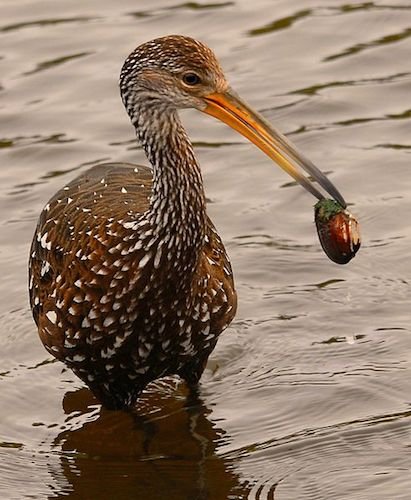Aramidae – Limpkin

The Aramidae has a lone member, the limpkin, which is also called carrao, courlan, and crying bird. It is a bird that looks like a large rail but is skeletally closer to the cranes. It is the only extant species in the genus Aramus. It is found mostly in wetlands in warm parts of the Americas, from Florida to northern Argentina. It feeds on molluscs, with the diet dominated by apple snails of the genus Pomacea. Its name derives from its seeming limp when it walks.
It is a large bird, 64cm to 73cm long, with a wingspan of 101cm to 107cm. Its body mass ranges from 900g to 1,300g, averaging 1,080g. The males are slightly larger than the females in size, but there is no difference in plumage, which is drab—dark brown with an olive luster above. The feathers of the head, neck, wing coverts, and much of the back and underparts (except the rear) are marked with white, making the body look streaked and the head and neck light grey. It has long, dark-grey legs and a long neck. Its bill is long, heavy, and down-curved, yellowish bill with a darker tip. The bill is slightly open near, but not at, the end to give it a tweezers-like action in removing snails from their shells, and in many individuals the tip curves slightly to the right, like the apple snails’ shells. The white markings are slightly less conspicuous in first-year birds. Its wings are broad and rounded and its tail is short. It is often confused with the immature American white ibis.
It is easier to hear than see. Its common vocalisation is a loud wild wail or scream with some rattling quality, represented as ‘kwEEEeeer’ or ‘klAAAar’. This call is most often given at night and at dawn and dusk. (It has been used for jungle sound effects in Tarzan films and for the hippogriff in the film Harry Potter and the Prisoner of Azkaban.) Other calls include wooden clicking, clucks, and in alarm, a piercing bihk, bihk.
It inhabits freshwater marshes and swamps, often with tall reeds, as well as mangroves. In the Caribbean, it also inhabits dry brush-land. In Mexico and northern Central America, it occurs at altitudes up to 1,500m. In Florida the distribution of apple snails is the best predictor of where limpkins can be found.
It undertakes some localised migrations, although the extent of these are not fully understood. In some parts in the northern part of the range females (and a few males) will leave the breeding areas at the end of summer, returning at the end of winter. Birds may also migrate between Florida and Cuba. In Brazil, birds breeding in some seasonal marshes will leave during the dry season and return again with the rains.
Limpkins are largely nocturnal and crepuscular, except that in Florida refuges, where they do not fear people, they are active during the day. Even so, they are usually found near cover.
Their long toes allow them to stand on floating water plants. They can swim well, both as adults and as newly hatched chicks, but they seldom do so. They fly strongly, the neck projecting forward and the legs backward, their wings beating shallowly and stiffly, with a jerky upstroke, mostly above the horizontal.
The Limpkin is one of those few species of birds which have a family of just one:
Limpkin Aramus guarauna
It has two sub-species:Aramus guarauna pictus in North America and Aramus guarauna guarauna in South America.
-
Limpkin Aramus guarauna
Species AccountSound archive and distribution map. -
Limpkin Aramus guarauna
Cornell Species AccountAn unusual bird of southern swamps and marshes, the Limpkin reaches the northern limits of its breeding range in Florida.
-
Number of bird species: 1
